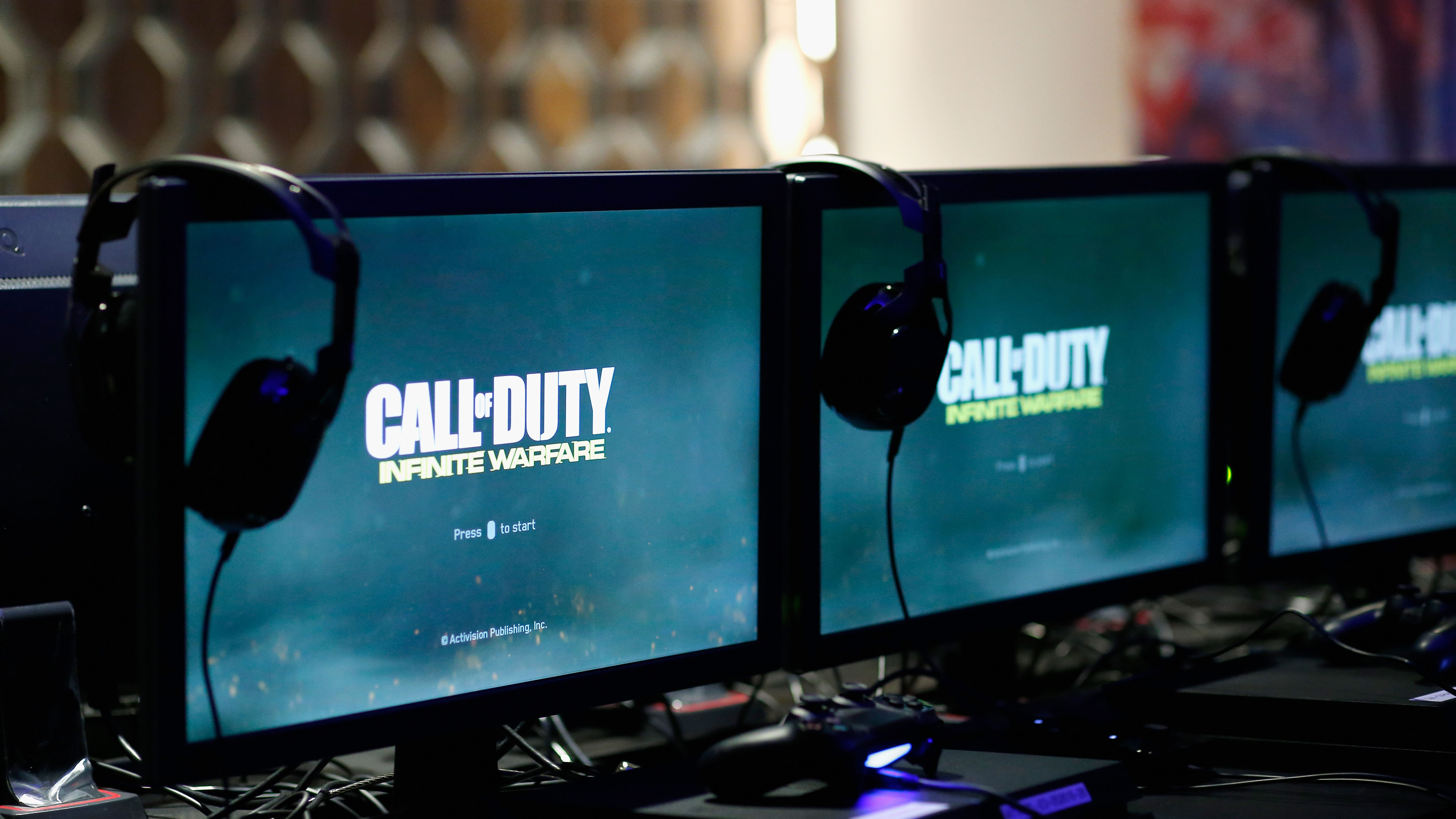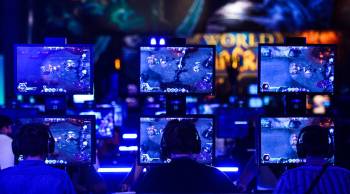
The rise, fall and future of the company behind World of Warcraft
The rise, fall and future of the company behind World of Warcraft

Close to one year ago, Microsoft’s acquisition of the video game company Activision Blizzard was finalized. The $68 billion deal was and is the largest video game acquisition ever. Beforehand, that title was held by Activision’s merger with Blizzard Entertainment’s parent company.
Now, you may not know the name Blizzard, but chances are you’ve seen their work: World of Warcraft ring a bell? The company has made headlines throughout its lifetime for breaking records, but also for its run-ins with the law.
Bloomberg News reporter Jason Schreier chronicled Blizzard’s run in his new book out on Tuesday titled, “Play Nice: The Rise, Fall and Future of Blizzard Entertainment.” He spoke with “Marketplace Morning Report” host David Brancaccio about his book. The following is an edited transcript of their conversation.
David Brancaccio: How does all this start and how big does Blizzard get? Give me a sense?
Jason Schreier: Oh, man. So Blizzard starts in 1991 with two guys, really just graduated college, and it grows into what I would call an empire with thousands of staff, millions of players and billions — with a “b” — of dollars.
Brancaccio: People are gonna know World of Warcraft, Diablo — that’s who we’re talking about.
Schreier: Yeah, I think the best analogy might be that Blizzard is the Pixar of video games.
Brancaccio: They’re not called Blizzard in the early years. They’re called something else with chaos in their name. But that also applies to the style of management. It seems very chaotic.
Schreier: Yeah, they switched names a few times before they finally landed on Blizzard. And as Mike Morhaime, the cofounder and CEO for a long time, recently told me, “We had no idea what we were doing back then.” Which I think is the case of a lot of startups, but when you’re two college students starting a company that grows and grows and grows and grows, you learn pretty quickly that like, “Oh, we have to have HR, turns out we have to actually run a company.” Which I think it took them a long time before they got to that point.
Brancaccio: Well, HR becomes a huge issue many years later; we will get to that. But on the way up yet, Warcraft — I think the early versions of that were not massive multiplayer, global extravaganzas. You played the game on your computer.
Schreier: Yeah, so what happened was the folks at Blizzard were making these games, and each one was a hit. Each one was more of a hit than the last. Warcraft begat Warcraft Two, begat Diablo, begat StarCraft — all of these games that would turn into billion-dollar franchises. Around 1999, a lot of the folks at Blizzard were playing a game called Everquest. I think the news used to call it “Evercrack,” because it was so addictive. Unlike a lot of other video game companies, which were run by business folks, this is a company that was run by people who love playing games, and so a lot of their output was kind of motivated by what they were playing.
And so since they were all playing Everquest and just constantly talking about what they liked, what they didn’t like, what they would do better, they decided, “Hey, why don’t we just make our own version of this: World of Warcraft.” Their most wildest, most optimistic projections was like, “Maybe we can reach a million subscribers. Everquest had half a million. Maybe we can double that.” Took a year, and they had 5 million subscribers. By 2008, 2009 they were up to 12 million subscribers, each paying monthly to play this game. So the amount of money is just mind-boggling.
Brancaccio: It’s more than a company. It’s more than a set of games. It becomes almost a way of life. That Blizzard annual convention. I never got to go, but they sound pretty intense.
Schreier: You know, what’s really cool about it, World of Warcraft — because it’s this virtual world, a lot of people meet friends in there. Some people even meet their spouses in World of Warcraft. Like, over the last couple of decades, people have really just built so many strong friendships and connections within that world and something that I saw at BlizzCon. So the BlizzCon I went to last year, in 2023, it was actually the first one since before COVID. So it had been a while. And something I saw that was pretty, pretty cool was people who were like friends, but hadn’t actually seen each other in four years since the previous BlizzCon — just like hugging and talking about their game experiences and the world. And it was very cool to see. I think Blizzard, one of their mantras from the beginning was that video games can bring people together, and I think it’s undeniable they accomplish that.
Brancaccio: But back to culture — making these things is hard. You have to create a universe, and there can be bugs. There’s this notion that you write about “crunch” when it gets close to deadline. People work crazy hours now, people listening to us will go, “Well, I work crazy hours when I’m close to deadline.” This seems to be in the video game industry. We’re talking about something times three or four.
Schreier: I think close to deadline is the part that was a little different back then, at least. Crunch has kind of changed, both at Blizzard and within the larger video game industry. The notion of it has changed, but back then, it was one of those scenarios. Imagine your boss is telling you, “All right, we’re two weeks away and that lasts for a year.” So you’re putting in the hours that you would put for your final sprint, your last two weeks for a crazy deadline, except that just lasts for months and months and months. So it damaged a lot of people. It hurt a lot of people’s relationships.
I spoke to one guy, David Brevik, who was the director of Diablo. He told me it cost him his marriage and really ruined his relationship with two of his children. So it really can be tragic for people. But on the flip side, you also talk to people, and some of them are like, “You know what? I was in my 20s. I had nowhere else to be. I just wanted to be in the office with my friends making games. And for me, it was kind of exhilarating.” So I think people have a lot of conflicting feelings about that kind of work culture, but it has changed. Very few companies are like that these days. This is kind of tech gaming in the ’90s. It was a little bit of a wild west, in many aspects.
Brancaccio: There’s the rise in Blizzard’s history, but then it’s more than hiccups. Let’s talk about the fall part of this. They’re gunning for a new game, and it doesn’t work out.
Schreier: Yeah. So what happened for a long time was that Blizzard had this kind of shuffling of corporate parents, and I think Blizzard’s executive staff were always able to manage up and shield the company by saying, “Hey, you give us time, you give us autonomy, and we will deliver hit after hit.” And that was true for a long time. Every game was bigger than the last, and then World of Warcraft came out, it was the biggest thing on the planet. So they were owned by Vivendi — the French company, Vivendi — merged their games unit with Activision — another big gaming publisher — to form Activision Blizzard. And part of the reason for Activision to get involved was the promise of this new big thing called Titan. Cut to 2013, six years after Titan started, and after the merger happened and Titan collapses, Blizzard cancels it. It costs them $80 million and lord knows how much an opportunity cost. And this is when Activision looks over and says, “Hey, you promised us that if we gave you time and autonomy, you would deliver hits. And that was not the case here.” And this is when the problems begin to really start for Blizzard, at least on the business end.
Brancaccio: Over at Activision, there’s this charismatic figure, Bobby Kotick, and it’s not like he doesn’t understand the gaming world, but he approaches things differently and sees some need for rules and regulations over there at crazy Blizzard.
Schreier: Blizzard was started by two guys who considered themselves big gamers, and they started the company because they wanted to make games that they liked playing. But Kotick, on the other hand, here is a guy who was kind of a born entrepreneur. He started his career as someone who was just interested in starting businesses or running businesses, making money, and soon it became clear that their values were just completely incompatible. Because at Bobby’s company, at Activision, his MO was to take a franchise and then, if it turned out to be a hit, to use his words, “exploiting it as much as possible,” making spinoffs and sequels and releasing new entries every single year — which I think did not fit with the Blizzard way of taking their time and really spending a lot more to try to make sure the games were distinct and have that kind of player-focus. Just two entirely different ways of doing business. Bobby Kotick, executive team was almost entirely people from the CPG space, from consumer product goods such as Procter & Gamble, which I think shows you how he wanted to do business. Which is very different than the Blizzard C-suite, which is almost entirely gamers and video game developers.
Brancaccio: But it’s such an interesting story for anyone who works within a creative industry, this kind of tension between “we have to do business here” and the suits versus the creative impulse and not staunching that. You can see it in movie studios. You can see it in podcasting. It’s all over any kind of creative industry.
Schreier: One hundred percent. I, just as a video game fan and a reporter, I think I probably would have been a little inclined to be like, “I want to root for the creative people.” But really my takeaway was that you have this spectrum, like creativity on one side and predictability on the other side. And I think the most successful companies have to be somewhere in the middle. And I think in this case, Blizzard was on the way, way end of creativity, and Activision was on the way, way opposite end of predictability, and the two companies just could not find a way to meet in the middle. They could not find compromises for a variety of reasons that I document in the book. But it really was a shame, because it just led to so many problems, and eventually led to a lot of Blizzard’s people leaving as a result.
Brancaccio: But we need to understand here, it’s not just, “Well, the cool kids, why didn’t they leave them alone over at Blizzard?” There was a culture problem there. In 2021, the state of California sued Activision Blizzard because of sexual harassment and an abusive work culture.
Schreier: Yeah, we’ve been talking about the business end of it all, and the cultural end is an entirely different set of problems. I think the biggest one — and the theme I heard most while talking to women who worked at Blizzard, especially — is that it was male-dominated. At the very beginning in the ’90s, it was probably 95% men, and then as it became a little more professional, as it brought in more women and wound up becoming about 20% women. None in the C-suite, none in the executive layers, none who were directing games, who were leading games. And that became a big problem. One of the biggest problems, I think, is that Blizzard — one of their values was to really put a premium on tenure at the company. And so people who had been there for 15, 20 years were often people who were in leadership. And the problem with that is, if you’re a woman, you weren’t there for 15, 20, years, because there were no women there back in the day. And so that really caused a lot of systemic problems.
And then you combine that with other instances that were really heinous, instances of sexual harassment and misconduct — some of that certainly fueled by the rise of World of Warcraft and the fame and fortune that it led some of these folks to have. I mean, you have this BlizzCon convention every single year, where some of these developers who might have been kind of not used to this kind of attention were suddenly being treated like rock stars. And because everybody’s kind of work lives and personal lives were intertwined, both because of the amount of work it took on Blizzard games and because of the nature of the company, everyone was really tight-knit within Blizzard. A lot of people dated each other on campus and married each other on campus, including some of the executives — including Mike Morhaime, including a lot of people on his team, marrying or dating people below them at the company. And that created a bunch of uncomfortable dynamics for some people who work there.
Brancaccio: Where are we with Activision Blizzard? I know Microsoft moved to buy Activision. I think it was in 2022. For Blizzard, this was a cultural shift.
Schreier: Again, massive cultural shift. A lot of people were really optimistic. People, I think, had really lost faith in the Activision C-suite, including Bobby Kotick. Something like 2,000 people all across the entire company signed a petition asking for him to be out of there. It took about two years for the deal to actually close because of all the regulatory battles they had to go through. And so that happened in October of 2023. And then about three months later, there was a mass layoff — the first of what would be several mass layoffs within the company. And a bunch of Blizzard staff, many of whom had been kind of rooting for the deal to go through, lost their jobs. And then to kind of get to where we are today, I think there’s a lot of uncertainty still. There are a lot of questions. Their current corporate owner is Microsoft, and specifically the Xbox gaming division within Microsoft has faced all sorts of obstacles this year — ironically, because of the Activision Blizzard deal. Because what happened was Microsoft allowed them to buy Activision Blizzard for $69 billion but then Satya Nadella and his team, Amy Hood and crew have been looking at the PNLs and saying, “Hey, well, you better start delivering. We gave you all this money. Now, what are you going to show for it?” And so Microsoft’s gaming division, Xbox, has been going through just a state of cost-cutting and trying to show as many profits as possible. And it has just been a complete mess in all sorts of ways. So people at Blizzard are just kind of sitting doing their jobs and just waiting to see what the future of the company looks like.
Brancaccio: Is there some big new project that you’re aware of that they’re trying?
Schreier: Yeah, they are. They are actually just coming out with an expansion to Diablo IV, which was their most recent successful game. It’s called Vessel of Hatred, and that should do well for them. They just released a new expansion for World of Warcraft called The War Within that has performed extremely well for them. A lot of people are saying World of Warcraft is in the best state it has been in a very long time. So from a product standpoint, they’re doing pretty well right now.
There’s a lot happening in the world. Through it all, Marketplace is here for you.
You rely on Marketplace to break down the world’s events and tell you how it affects you in a fact-based, approachable way. We rely on your financial support to keep making that possible.
Your donation today powers the independent journalism that you rely on. For just $5/month, you can help sustain Marketplace so we can keep reporting on the things that matter to you.


















